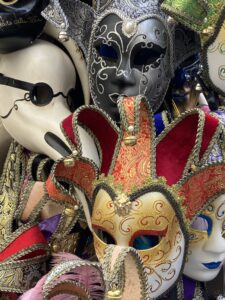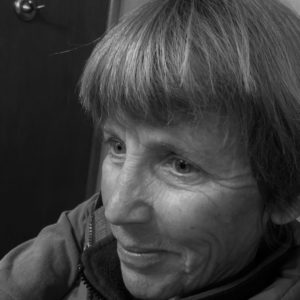 Ever since reading Alfred Kazin’s A Walker in the City, I’ve approached the art of the passeggiata with a new sense of awe. Far from being a simple feat of forward movement, a stroll is an act of discovery, a gourmet meal of the senses. We prowl and sniff and stop and listen and sniff again, just like the four-footers we know. Sometimes we’re purposeful, ticking off the miles from one place to another. Sometimes we’re dreamy, stopping at the pasticceria for a sfogliatella, or pausing under an open window on a narrow street to eavesdrop on the lives of those who are not wanderers. The stay-at-homes, we call them, without a drop of envy, knowing too soon—maybe even in a matter of hours—we’ll be headed home to a similar fate.
Ever since reading Alfred Kazin’s A Walker in the City, I’ve approached the art of the passeggiata with a new sense of awe. Far from being a simple feat of forward movement, a stroll is an act of discovery, a gourmet meal of the senses. We prowl and sniff and stop and listen and sniff again, just like the four-footers we know. Sometimes we’re purposeful, ticking off the miles from one place to another. Sometimes we’re dreamy, stopping at the pasticceria for a sfogliatella, or pausing under an open window on a narrow street to eavesdrop on the lives of those who are not wanderers. The stay-at-homes, we call them, without a drop of envy, knowing too soon—maybe even in a matter of hours—we’ll be headed home to a similar fate.
Kazin opens his book with the line, “Every time I go back to Brownsville it is as if I had never been away.” The smells and sights and sounds, the pickle stand, the old women in their housedresses, the screech and cry of the subway—cacophonous Brooklyn overwhelms him with its familiarity. And it unnerves him as well. The world he moved away from has remained unmoved. It’s right there to greet him—and taunt him—the moment he returns.
Unlike Kazin, the worlds I’ve left behind in my life have, for the most part, let go of me. They’ve shaken me off and forgotten me. Or is it the other way around? If I return to them, or pass through them on my way somewhere else, they feel unfamiliar. An old house has gone down and a multi-story apartment complex has risen in its place. A favorite corner market has become a real estate office. A park has been paved and a river has been dammed. Affronts are everywhere. What I once loved has been put to earth and what’s left is a misbegotten resurrection.
So I was doubtful it would be any different on a recent trip to Italy. I wondered if Venice would still be a magical city of water and light. I wondered if Rome would feel creatively chaotic or like an overcaffeinated city of motorini and pickpockets. My intention was to walk as much as possible through the Italy I had known as a student there in 1974. I wanted to slow down to a strolling pace and see if it was feasible not to hurry in a world of cell phones and internet and a general post-Covid movement of bodies through space. Many more people were traveling, I reminded myself, in human packs and moving quickly. The compulsion for most was to see as much as the eyes could take in, then to move on to the next place; to tick off museums and works of art like birdwatchers with their life lists.
Despite the hurry, despite the need for every twenty-something in the world to go home with a selfie of an unforgettable kiss on the Spanish Steps, or a frolic with a stranger knee-deep in the Trevi Fountain, or the large and loud presence of most American tourists in the hushed halls of the Vatican Museum, standing beneath Michelangelo’s masterpiece, travel leaves me hopeful. It creates the opportunity for empathy. It’s the mending stitch in the torn fabric of intertribal relations.
I was traveling with my friend, Lynne, and our first stop was Venice. The sensation of dropping straight from the sky still overwhelms me whenever a jet touches down, bounces along a runway at breakneck speed, and a voice announces an arrival in a city so far from home it defies the imagination. But our drop from above into Venice took a different turn. We stepped off the airport bus and were immediately surrounded by masked courtiers, elaborately wimpled nuns, and Superman sporting a cape made from an American flag. There were T. rexes sipping espressos alongside 17th Century ladies. I remembered the storybook ways of Venice, the beauty and novelty of a city built on water. But this theatrical display of costumes and masks and music pouring from every piazza, combined with jet lag—the whole scene left me blinking in awe. And puzzled. Had Venice descended into madness while the world around it plodded along in its usual quotidian way?
Yes and no, a helpful priest explained. It was Carnevale. Mardi Gras. Benvenuto! he cried, and sashayed along the canal in a suspiciously unpriestlike manner. Who was or wasn’t in costume then became a guessing game. Soldiers and jailers; widows and witches; women ballooning outward in stiff petticoats; orange-haired courtesans wearing masks of painted paper-mache; silk-stockinged men in tri-cornered hats, bowing to friends along the street or shaking their canes in hot debate. A riot of visual delights and deceptions, this is the way Venetians prepare for the rigors of Lent.
For ten days each year, everyone becomes an actor on the great stage of the aqueous city, and then as suddenly as it began, it’s over. The processions and entertainments give way to the early morning street cleaners sweeping up confetti with their bamboo brooms. Cheap masks made in China litter the Piazza San Marco. The fog lifts over the Venetian lagoon and the spires of the island churches pierce the last shreds of low-hanging clouds. A man calls out, selling hats, ordinary hats, indicating the revelry is over, and the dome of the great cathedral reasserts its dominance over wild Venetian hearts.
Lynne and I walk the city. It’s a quieter city today. We stroll its narrow streets, crossing the bridges great and small that stitch and separate neighborhoods, crossing the winding canals of the Jewish Quarter where the apartment dwellers parallel park their boats. Everywhere, the sound of water lapping and the rich voices of the gondoliers; the sound of motors, and handcarts bumping over cobblestones. Beneath my window one morning, a long thin delivery boat carries crates of apples and clementines. The two boatmen speak above the noise of the motor and their voices echo off the walls of the canal. An intimate city, a floating city, a drowning city when the acqua alta comes, as it does several times a year, driven by moon and tide. The lagoon overflows the piazzas then, sending the tourists inside, while outside it’s business as usual for the imperturbable Venetians who don their high rubber boots and wade out into the day.
And the day is inevitably filled with light in this city of water and light. Even in the rain there appear, from between the buildings, shafts of light as if blown in from the lagoon. When our time is over, we throw our packs on our backs and walk, not wishing to hurry, not wishing to leave, to the train station. This is where the transformation takes place, always in the crowded coffee shop of the station, any station, where one skin is peeled off and left behind in order for the next place to catch hold. A separation has to happen while eating the panino and sipping hot tea, and we turn our conversation to Rome. But as Alfred Kazin writes, “When we went home, taking the road past the cemetery, with the lights of Jamaica Avenue spread out before us, it was hard to think of them as something apart, they were searching out so many new things in me.” I take this to mean it is entirely possible that the train never arrives and the tea grows cold; that “past and present become each other’s faces,” as Kazin writes, and we never leave at all.

